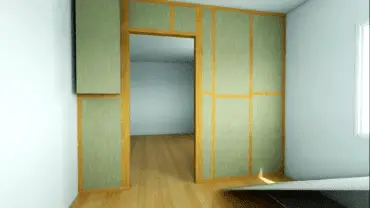How to Install a Range Hood in Your Kitchen
Whether you’re looking to upgrade your kitchen ventilation or enhance your cooking experience, installing a range hood is an intelligent choice.
In this easy-to-follow guide, we will walk you through each step of the installation process, providing you with the knowledge and confidence to achieve proper ventilation for efficient cooking.
Before we dive into the installation process, let’s briefly discuss what is a range hood is and its types.
What is a Range Hood & Its Types?
A range hood is a kitchen appliance designed to eliminate smoke, odors, and grease from your kitchen but also prevents the buildup of harmful pollutants. It improves air quality, protects your cabinets from grease stains, and reduces the risk of fire hazards.
There are various types available, including wall-mounted, under-cabinet, island, ducted, and ductless range hoods, each suited for specific kitchen layouts and requirements.
Now, let’s get started with the installation process.
Assess Your Kitchen for Range Hood Installation
Before you begin installing your range hood, it is essential to assess your kitchen space to ensure a successful installation.
By taking the time to consider critical factors, such as kitchen ventilation, measuring kitchen space, and available mounting options, you can determine the best location for your range hood.
Kitchen Ventilation
Assess the ventilation needs of your kitchen to determine the type of range hood that will provide optimal results. Consider factors such as cooking habits, kitchen size, and the amount of smoke, odors, and grease produced during cooking.
If you frequently cook greasy foods or have a large kitchen, a range hood with a higher CFM (cubic feet per minute) rating may be necessary to remove smoke and odors effectively. For smaller kitchens or lighter cooking, a range hood with a lower CFM rating may suffice.
Measuring Kitchen Space
Measure the available space in your kitchen to determine the appropriate size of the range hood. Start by measuring the width of the cooking surface or range, and then calculate the minimum required width for your range hood, ensuring it extends at least 3 inches beyond the edges of the cooktop.
Additionally, measure the distance from the cooking surface or range to the nearest wall or cabinet. That will help you determine if you need a wall-mounted or under-cabinet range hood and if any modifications or additional support will be required.
Available Mounting Options
Consider the available mounting options in your kitchen when choosing the type of range hood that will work best for your space.
Wall-mounted range hoods are ideal for kitchens with no existing cabinetry above the range, while under-cabinet range hoods fit neatly beneath existing cabinets.
Gather the Necessary Tools and Materials
To successfully install a range hood in your kitchen, you will need a range of tools and materials. Here is a list of the essential items you’ll need:
Tools
- Long drill bit
- Screws
- Wire connectors
Materials
- Vent hood
- Ductwork (if applicable)
- Ground wire (if required by local electrical codes)
Prepare for Installation by Cutting a Hole
Before installing your range hood, it’s essential to prepare by cutting a hole in the appropriate spot on your kitchen wall or ceiling. This hole will allow for proper ventilation and exhaust of air while cooking.
To begin, measure the size of the range hood vent hole based on the manufacturer’s specifications. It will ensure a proper fit and efficient airflow. Check the installation manual or the product website for the recommended size.
Once you have the measurements, you’ll need a saw to cut the hole. Make sure to use a saw that is suitable for the material of your wall or ceiling. Use caution and follow safety guidelines while operating the saw, wearing protective goggles and gloves.
Remember to double-check your measurements before cutting to avoid any mistakes. It’s always better to measure twice and cut once.
After the hole is cut, clean up any debris or dust to ensure a clean and smooth installation. It will prevent any interference with the range hood’s performance or appearance.
Install the Electrical Wiring
Proper electrical wiring is crucial for the safe and efficient operation of your range hood. Regarding range hood electrical wiring, it’s essential to follow the steps to ensure a successful installation.
If you are not comfortable working with electricity, hiring a professional electrician to handle this task is highly recommended.
Installing an Electrical Box
To begin the electrical work for range hood installation, you will need to install an electrical box near the location where your range hood will be mounted. The electrical box serves as a secure enclosure for the wiring connections.
Start by determining the best location for the electrical box. It should be easily accessible and positioned by local electrical codes. Use a stud finder to locate a suitable spot on the wall or ceiling.
Once you have identified the location, trace the outline of the electrical box on the wall or ceiling. Carefully cut the designated area using a drywall saw or appropriate cutting tool. Make sure to follow safety precautions when using cutting tools.
After cutting the hole, insert the electrical box into the opening and secure it using the provided screws. Ensure that the box is flush with the wall or ceiling surface for a neat and secure installation.
Connecting the Wiring
Now that the electrical box is in place, you can proceed to connect the wiring for your range hood. Before starting the wiring process, make sure the power supply to that area of your kitchen is turned off at the circuit breaker. Safety should always come first.
- Remove the cover of the electrical box and locate the wiring terminals. These terminals are typically labeled with letters or symbols indicating their function.
- Refer to the manufacturer’s instructions for your specific range hood model to identify the correct wiring connections.
- Strip the insulation off the ends of the range hood’s electrical wires to expose the bare copper wire.
- Securely attach the black (hot) wire to the corresponding hot terminal in the electrical box. Repeat this step for the white (neutral) wire and the green or bare copper (ground) wire, if applicable.
- Tightly screw the wire connectors onto the connections, ensuring a secure and reliable bond.
- With the wiring connections complete, carefully tuck the wires into the electrical box, making sure they are not pinched or strained.
- Finish the installation by replacing the cover of the electrical box.
Mount and Secure the Range Hood
Now that you have completed the electrical wiring, it’s time to mount and secure your range hood. This step is crucial to ensure the stability and proper functioning of your hood. Follow these steps to mount your range hood securely:
- Locate the mounting brackets that came with your range hood. These brackets will be used to attach the hood to the wall or ceiling.
- Hold the range hood against the wall or ceiling in the desired location. Use a level to ensure that the hood is straight and aligned correctly.
- Once the range hood is positioned correctly, mark the locations for the mounting screws on the wall or ceiling.
- Pre-drill pilot holes at the marked locations using an appropriate drill bit.
- Attach the mounting brackets to the wall or ceiling using the screws provided. Make sure the brackets are securely fastened.
- With the mounting brackets in place, carefully lift the range hood and hook it onto the brackets.
- Double-check that the range hood is level and secure. Make any necessary adjustments to ensure a proper fit.
- Tighten the screws on the mounting brackets to firmly secure the range hood in place.
Once the range hood is mounted and secured, please gently tug it to ensure it is firmly in place. This will help you verify that the installation is solid and stable. When the range hood is securely mounted, you can proceed to the next step of the installation process.
Connect and Install Ductwork (if applicable)
If you have a vented range hood, it is essential to connect and install the necessary ductwork to direct the air outside. This step is crucial for ensuring proper ventilation and maintaining a clean and odor-free kitchen.
Start by attaching the ductwork to the range hood using tape or clamps. Make sure the connections are secure to prevent any air leakage. Refer to the manufacturer’s instructions for specific guidance on connecting the ductwork.
Next, determine the best route for the ductwork based on your kitchen’s layout. Consider factors such as the distance to an exterior wall or the roof. If you choose to vent through the roof, ensure you follow local building codes and regulations.
Once you have determined the route, carefully position the ductwork to avoid any obstacles or obstructions. Make sure the ductwork is adequately supported and secured.
When installing the ductwork, it is crucial to create a sealed connection. It will prevent any air leaks and ensure optimal range hood performance. Use foil tape or metal clamps to secure the joints and provide a tight seal.
After installing the ductwork, inspect the entire system to ensure everything is correctly connected and aligned. Check for any gaps or loose connections and make the necessary adjustments.
Complete the Installation and Test the Range Hood
Now that your range hood is securely mounted and the necessary ductwork is connected (if applicable), it’s time to complete the installation and ensure proper ventilation in your kitchen.
Follow these final steps to wrap up the process:
Secure All Connections
Before testing the range hood, double-check that all electrical and ductwork connections are secure. That will prevent any potential issues or leaks during operation.
Test For Proper Ventilation
Turn on the range hood and observe the airflow to ensure proper ventilation. Stand near the cooking area and feel for the movement of air.
Adequate ventilation removes cooking odors, smoke, and airborne particles.
Adjust Fan Speed and Settings
Play around with the different fan speeds and settings options on your range hood to find the most suitable configuration for your cooking needs.
Higher fan speeds are typically required for heavy-duty cooking, while lower speeds work well for lighter cooking activities, reducing noise and energy consumption.
By completing these steps, you can ensure that your range hood is fully installed and operating optimally to provide a clean and pleasant cooking environment.
Legal Requirements to Install Range Hood
The legal requirements for installing a range hood can vary based on local building codes. In many areas, obtaining a permit from the local permitting department may be necessary before proceeding.
Permits are typically required for modifications affecting the property’s structure, such as installing ductwork or making electrical connections.
Compliance with these regulations ensures safety, functionality, and adherence to local standards. Even for straightforward replacements without changes to gas, plumbing, or electrical lines, it’s essential to check permit requirements with the local authorities.
Homeowners should also consider any guidelines from homeowner’s associations. Staying informed and obtaining necessary permits is crucial for completing a range hood installation safely and correctly.
Conclusion
Installing a range hood in your kitchen is a wise investment that can significantly enhance your cooking space’s ventilation and air quality.
With the help of this easy installation guide, you can effortlessly transform your kitchen into a more functional and enjoyable environment for all your culinary adventures.
Remember, safety should always be your top priority when undertaking any DIY project. If you feel unsure about any steps or encounter any difficulties, it’s best to consult a professional for guidance.
FAQ
Range hood installation costs typically range from $200 to $500, depending on factors like complexity, ductwork requirements, and labor fees.
Range hoods can be vented outside to effectively remove odors and grease, but they can also recirculate air with a charcoal filter if venting outside isn’t feasible.
Installing a range hood yourself can be manageable if you’re comfortable with basic home improvement tasks like drilling, mounting, and potentially some electrical work. Be sure to review the installation instructions thoroughly and consider hiring a professional for more complex installations involving significant rewiring or structural modifications.
Recommended For You:
- What is the Most Expensive Part of a Kitchen Remodel?
- How to Remove Paint from Kitchen Cabinets: DIY Guide
- How to Pair Kitchen and Dining Lights?
- How is a kitchen Island Attached to the Floor?
- 9 Creative Ways to Use Windows in a Kitchen Remodel
- Why Are Kitchen Cabinets So Expensive? (Tips to Cut Costs)



